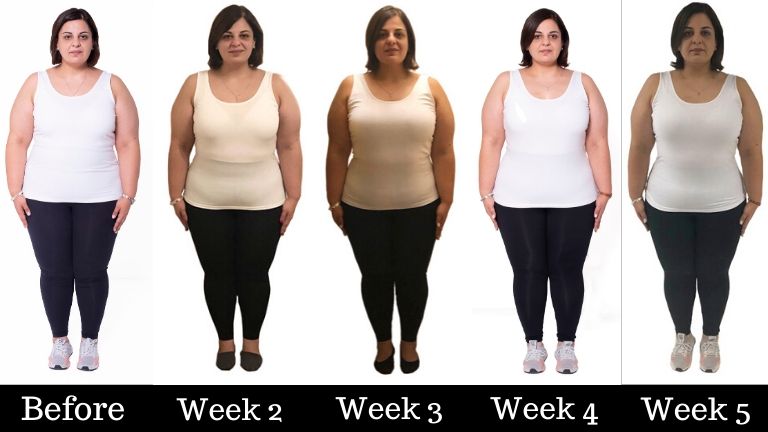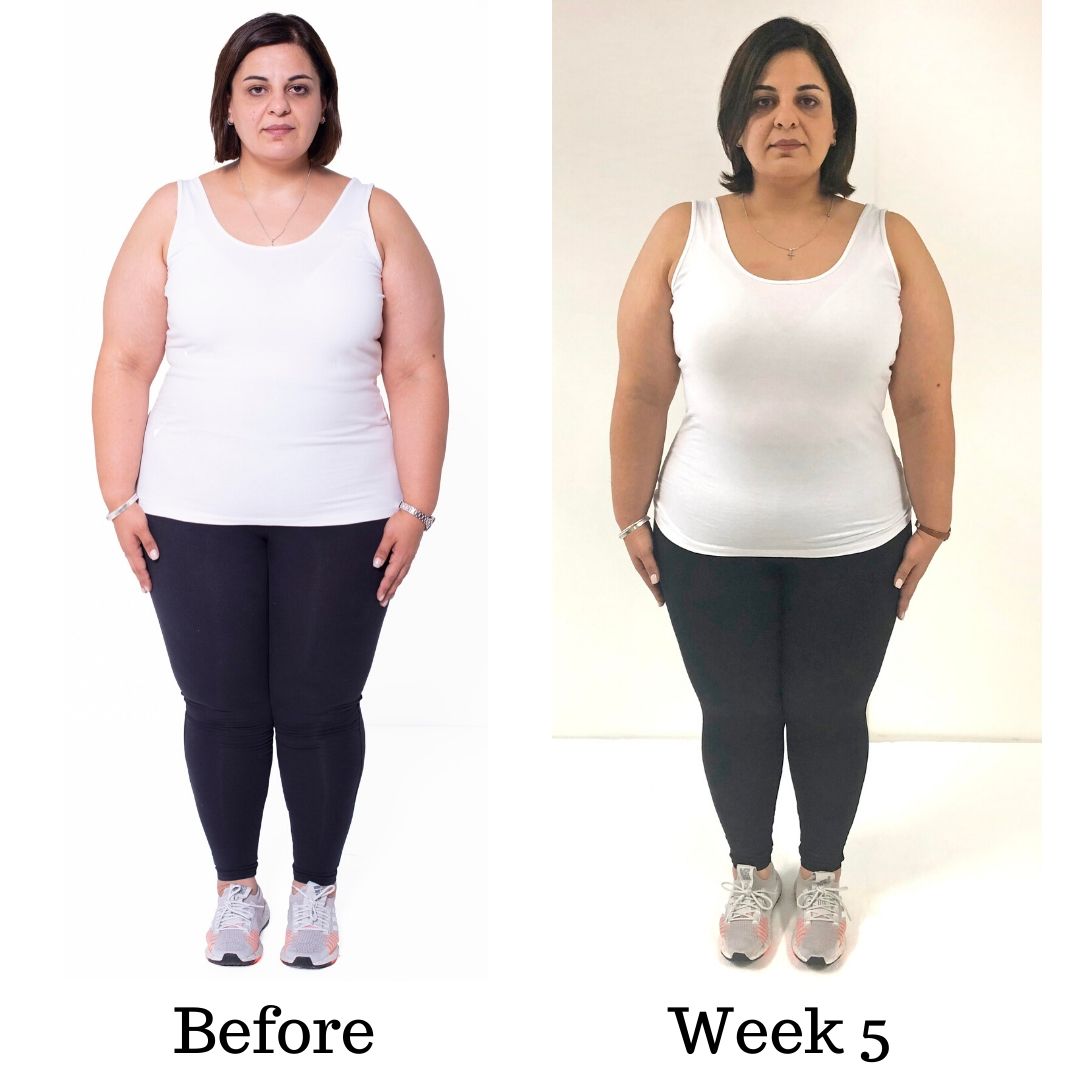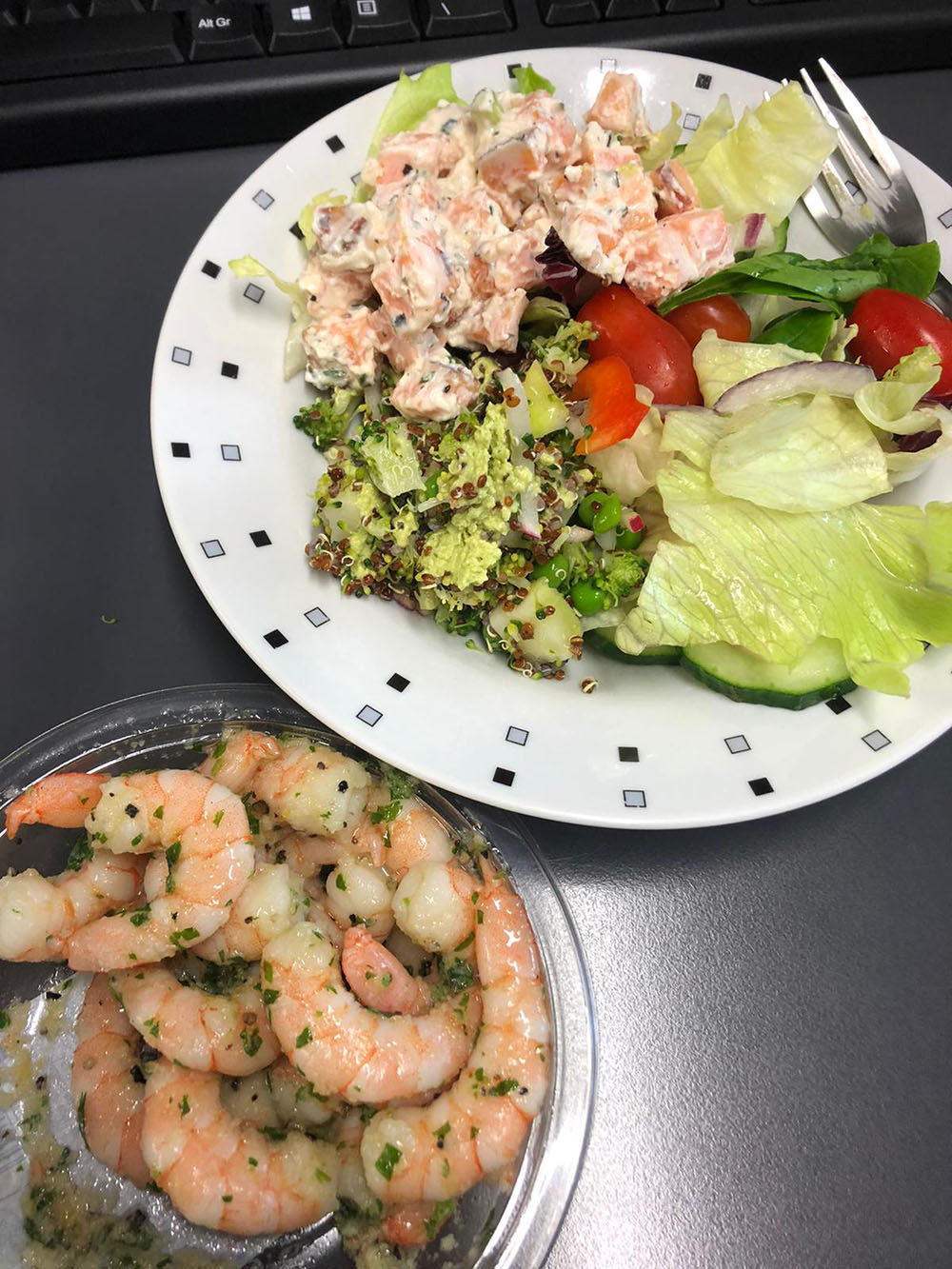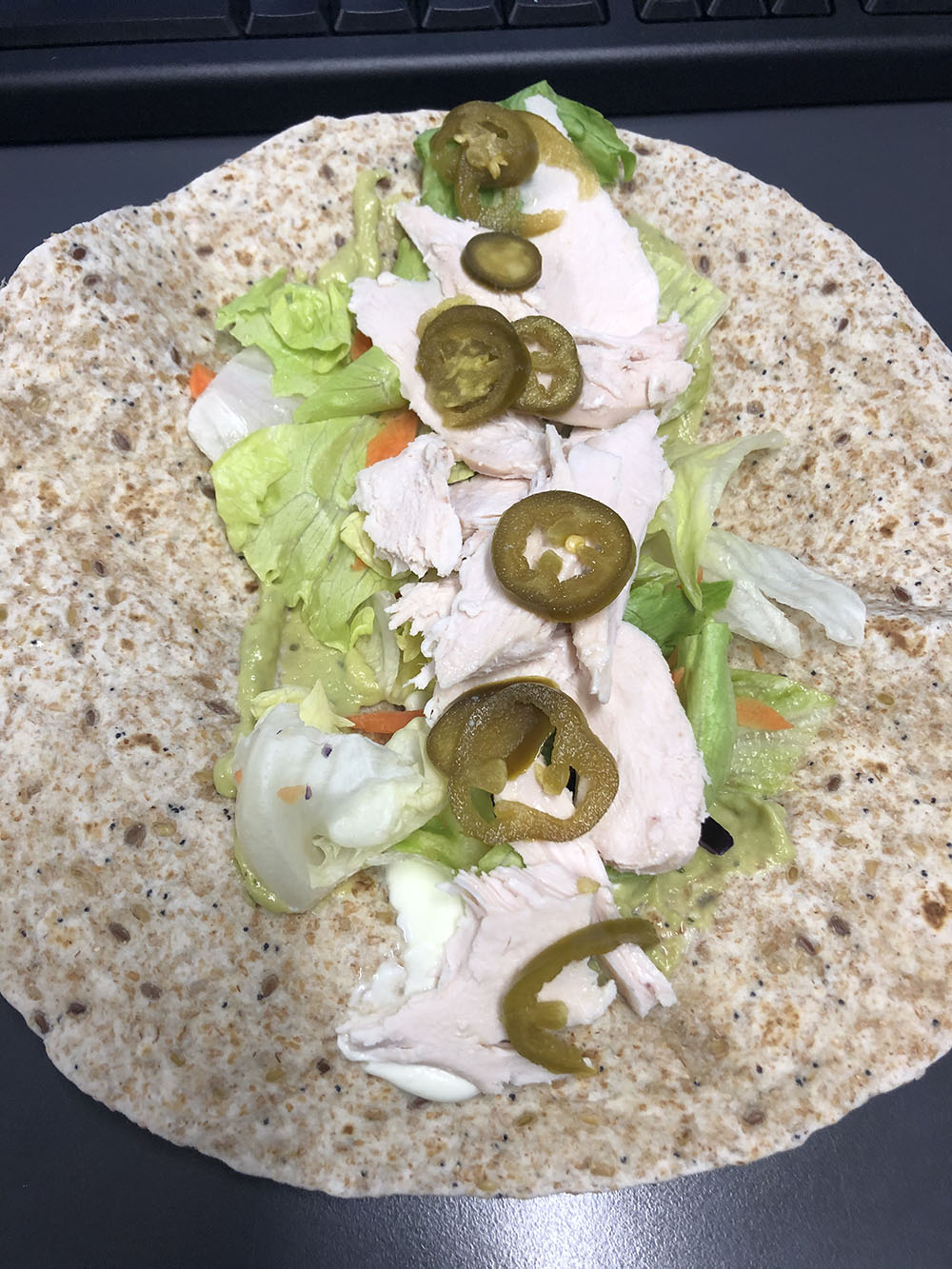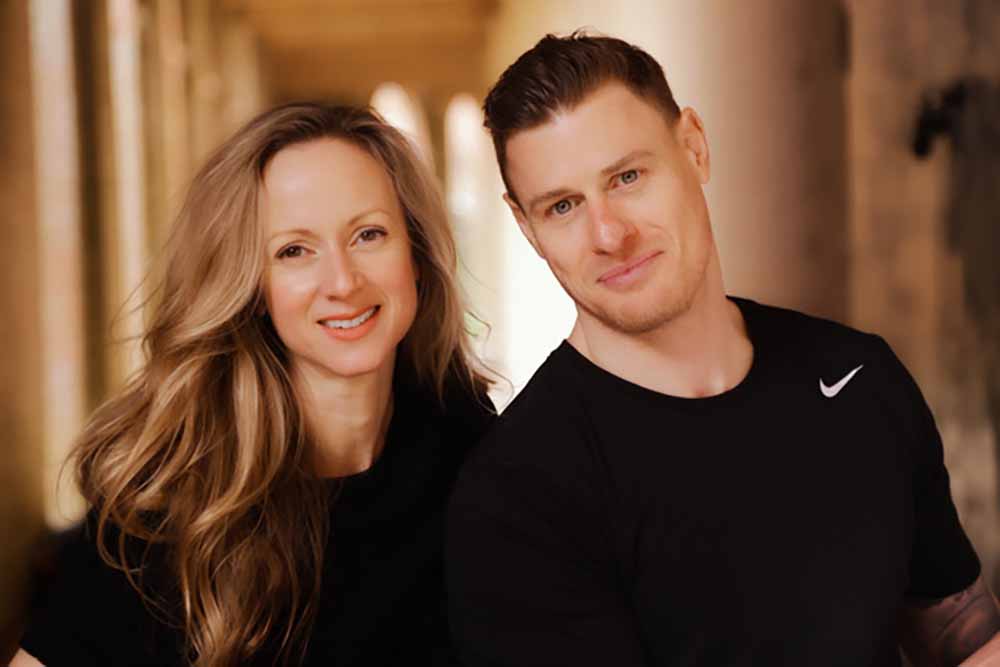Dina Hinar has lost almost six kilos in five weeks on her body transformation with trainer Terry Fairclough – here is exactly what she eats to lose weight
Hello again everyone, it’s now week five of my 10 week transformation with Your Body Programme.
I am nearly half way through and this week I have lost another 0.6 kgs – that’s just under 1.5 pounds. I am getting there slowly but surely and have lost a total of six kilos in five weeks so far.
I have been searching for a weight loss programme that wouldn’t just be easy to maintain in the long-run but also one that I would enjoy and not end up resenting.
I work in the same office as the Healthista girls and after going to them for weight-loss advice they told me about Terry Faiclough and Luisa Valenti and their amazing, Your Body Programme.
Founder Terry is a personal trainer and nutritional therapist after being a chef for ten years and co-founder Luisa is also a personal trainer after a previous career as a dancer. Terry is also a celeb trainer – but he doesn’t dish the dirt or name names on which celebs he trains…
Your Body Programme focuses on individual body types and provides a personalised programme, with exercises and a nutrition plan that matches your specific body type for the best weight loss results. (Click here to see what body type best describes you).
| Before | End of Week 1 | End of Week 2 | End of Week 3 | End of Week 4 | |
| Weight (kg) | 120 | 116 | 115.5 | 114.8 | 114.2 |
| Chest (centimetres) | 118 | 116 | 115.5 | 112 | 110 |
| Waist (centimetres) | 115 | 114 | 113 | 112 | 108 |
| Hips (centimetres) | 141 | 139 | 137 | 135 | 132 |
| Total weight-loss | N/A | 4 | 4.5 | 5.2 | 5.8 |
My transformation mentors have said that for me, gradual weight-loss is important because it will be more maintainable in the long run. That’s because gradual weight loss usually means no extreme changes to your diet or your daily routine.
My goal at the beginning of this transformation was to lose one to two pounds per week, with no extreme diet and no killing myself in the gym for hours a day.
In fact, I spend two days a week doing resistance training with Terry and Luisa, and then I do two to three cardio sessions a week, wherever I can fit them in.
Cardio is important for me because my body type is an endomorph, meaning I lay down fat easily. For more information on exercising for your body type see what I wrote about in week three.
My goal at the beginning of this transformation was to lose one to two pounds per week
Where food is concerned though, there have of course been some changes to my diet, but Terry and Luisa haven’t given me any extreme restrictions or suggested an impossible eating plans.
Instead of restrictions and strict rules, the type of diet changes that Terry and Luisa have suggested involve me eating healthier and more nutritious foods that will help fuel my workouts and my day, while keeping me fuller for longer in order to stop me snacking on the naughty stuff.
So, this week I thought I would go into more detail on exactly what Terry and Luisa have suggested I eat during this transformation. From what you definitely should be eating to lose weight, what you should probably limit and what you might want to avoid, I’m going to tell you exactly what I have been eating to help me lose weight.
Here’s what a typical day of food looks like for me:
8am, Breakfast: 2 egg omelette with avocado and tow pieces of rye bread.
1pm, Lunch: Brown pasta with chicken and prawns and a side salad
6pm, After Gym: Healthista Lean Vegan Diet protein shake, rich chocolate flavour
7pm, Dinner: Salmon and prawns with vegetables such as cauliflower, green beans or broccoli.
But first things first – before working out what food you should be eating, you firstly need to work out how much you’ll need to be eating.
Use this calculator to see exactly how many calories and macros should be eating for your body type.
Food you definitely SHOULD BE eating to lose weight
Eat a minimum of six vegetables per day
It goes without saying that when you are looking to lose weight and adopt a healthier lifestyle, vegetables are going to be involved, and there are a few good reasons for this.
Firstly, vegetables are low in calories, which means you can eat more of them. Eating more veggies will keep you fuller for longer but without taking up too much of your daily calorie allowance.
Take broccoli as a veggie example; 100 grams of broccoli contains just 34 calories, compare that to 100 grams of oats, which contains 389 calories.
Of course, you wouldn’t necessarily eat 100 grams of either of these foods in one go, but you get the point. If you were starving hungry, you would be able to eat waaaaayyy more broccoli than you would oats in order to feel full and satisfied.
Secondly, veggies are an important source of dietary fibre. Fibre is lacking in the average UK diet, with most of us only achieving 50% of the recommended intake.
But why is fibre so important I hear you ask? Well dietary fibre is important for our digestive health and it helps regulate bowel movements.
Your gut loves fibre and thrives off the diversity of eating plant based foods, plus studies have shown that fibre helps reduce the risk of heart disease, type 2 diabetes, high cholesterol and balance blood sugar levels as well as maintain a healthy weight and promoting good digestion.
Fibre also helps you feel fuller for longer which is important when dieting to stop you from snacking where you don’t need to and using up those daily calories. It is recommended that women consume around 25 grams of fibre per day.
Fibre is lacking in the average UK diet, with most of us only achieving 50% of the recommended intake.
A study on 252 women found that for every one gram increase in total dietary fiber, their weight decreased by 0.55 pounds (0.25 kg) and their fat decreased by 0.25 of a percentage point.
Using broccoli as an example yet again (because it’s my fave), one cup of raw broccoli (that’s about 70 grams) contains 3.8 grams of fibre and one cup of raw carrots with the skin still on (that’s about 50 grams) contains 6.9 grams of fibre.
So, you can see why it’s important to eat around six different types of vegetables per day to make sure you are getting the required amount of fibre your body needs but for less calories.
If you find yourself stuck at work with no pre-prepared vegetables for lunch (which I often do) then grab yourself a bag of salad, it may not fill you up as much as vegetables do, but you will still be getting essential nutrients and fibre into your meal.
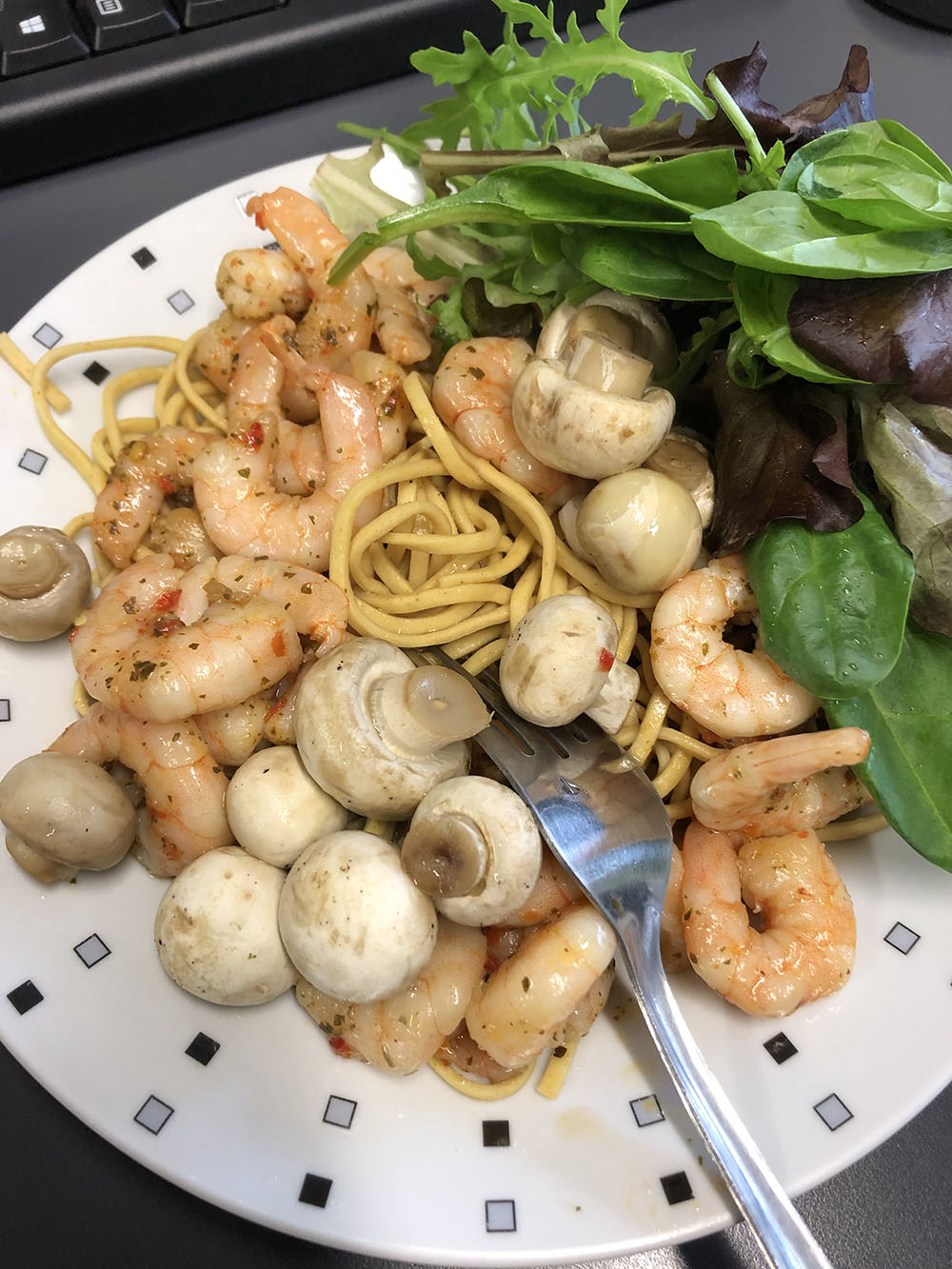
In fact, new recommendations now suggest that your daily fruit and veg intake should be ten portions and not five. So when I say a minimum of six I really do mean a minimum, but really you should be aiming to eat as much veg as you possibly can.
And the third reason vegetables are such an important part of your diet? Because they are so amazingly good for you in every way.
Vegetables contain phytonutrients. These are plant compounds that act as antioxidants in the body and help to reduce inflammation and the damage caused by excess free radicals that can build up because of a poor diet, environmental factors and stress, leaving us vulnerable to illness.
The compounds I am talking about is what give vegetables their bright colours. Beta carotene is found in orange and green varieties, anthocyanins is found in blue and purple varieties and lycopene can be found in red varieties.
Plus veg is so easy to prepare, boil it, steam it or roast it in bulk.
If you’re eating ten different vegetables a day then the chances are you will be a pretty healthy person, which will increase your protection against diseases as well as help you maintain a healthy weight.
Some people may feel that cost is an issue when it comes to buying loads of veg, but frozen vegetables can provide a cheaper way to add these foods to your diet, without losing out on nutrients.
Plus veg is so easy to prepare, boil it, steam it or roast it in bulk. Keep it cooked in the fridge so there is always a healthy option for you to reach for when you are feeling particularly hungry after a hard training session.
What to do:
- Fill up half of your plate with veggies at every meal.
- Try to eat a minimum of six different vegetables per day
Always make sure your plate contains a protein source
As well as filling up your plate with veggies, make sure there is an element of protein on your plate and if their isn’t, well shame on you because protein is absolutely essential to the human body.
Protein contains amino acids that are the building blocks of all our cells and our bodies can’t make these on their own. It also helps the body to build lean muscle tissue and is what gives the body shape. This is important when you are training because it means you don’t get any muscle wasting, but instead are constantly fueling your muscles to shape and grow.
Foods that contain protein include all types of meat, poultry, eggs, dairy (yoghurt) and fish, but also vegetarian sources such as tofu and tempeh, lentils and pulses, beans and nuts.
Check out my lunch that contains both vegetables, carbs and a protein source of prawns. This is a great example of what your plate (plates) should look like.
According to government guidelines, your protein consumption should be 0.8 grams per kilogram of body weight. For an average sedentary woman, this is around 46 grams of protein per day and 56 grams for men.
However, this is the minimum daily average; your protein requirement will be based on your personal health goals and lifestyle as well as factors such as activity levels, age, muscle mass and your current health status.
We are all unique and have very individual requirements but take a look at these examples:
- If you’re an average healthy woman with a sedentary lifestyle aim to consume 1.0g/kg of body weight per day.
- If you exercise regularly aim to eat 1-1.6g/kg of body weight per day.
- If you’re very active and focusing on resistance training, consume around 1.2-2.0g/kg of body weight a day.
- If you want to lose weight and are training around three times per week, eat 1.2-1.5g/kg of body weight per day.
- If you’re a super fit endurance athlete aim to consume, 1.3-1.6g/kg of body weight.
An average woman of 70kg should be eating around 70 – 90 grams of protein per day.
Another key benefit of protein at each meal is because it helps keep you fuller for longer, just as fibre does. That means having protein at each meal and snack translates to fewer calories between eating opportunities.
A randomised crossover study was performed on 40 men and 39 women, who ate diets of either 5%, 15%, or 30% of calories from protein. The participants who consumed 30% worth of calories from protein ended up eating an average of 575 fewer calories per day.
So what does eating lots of protein mean in real food terms? Well, a lot of chicken, for starters. I am having chicken breast or eggs with vegetables or salad for at least one meal each day. I am also eating lots of fish such as tuna or poached salmon and I absolutely cannot get enough of prawns.
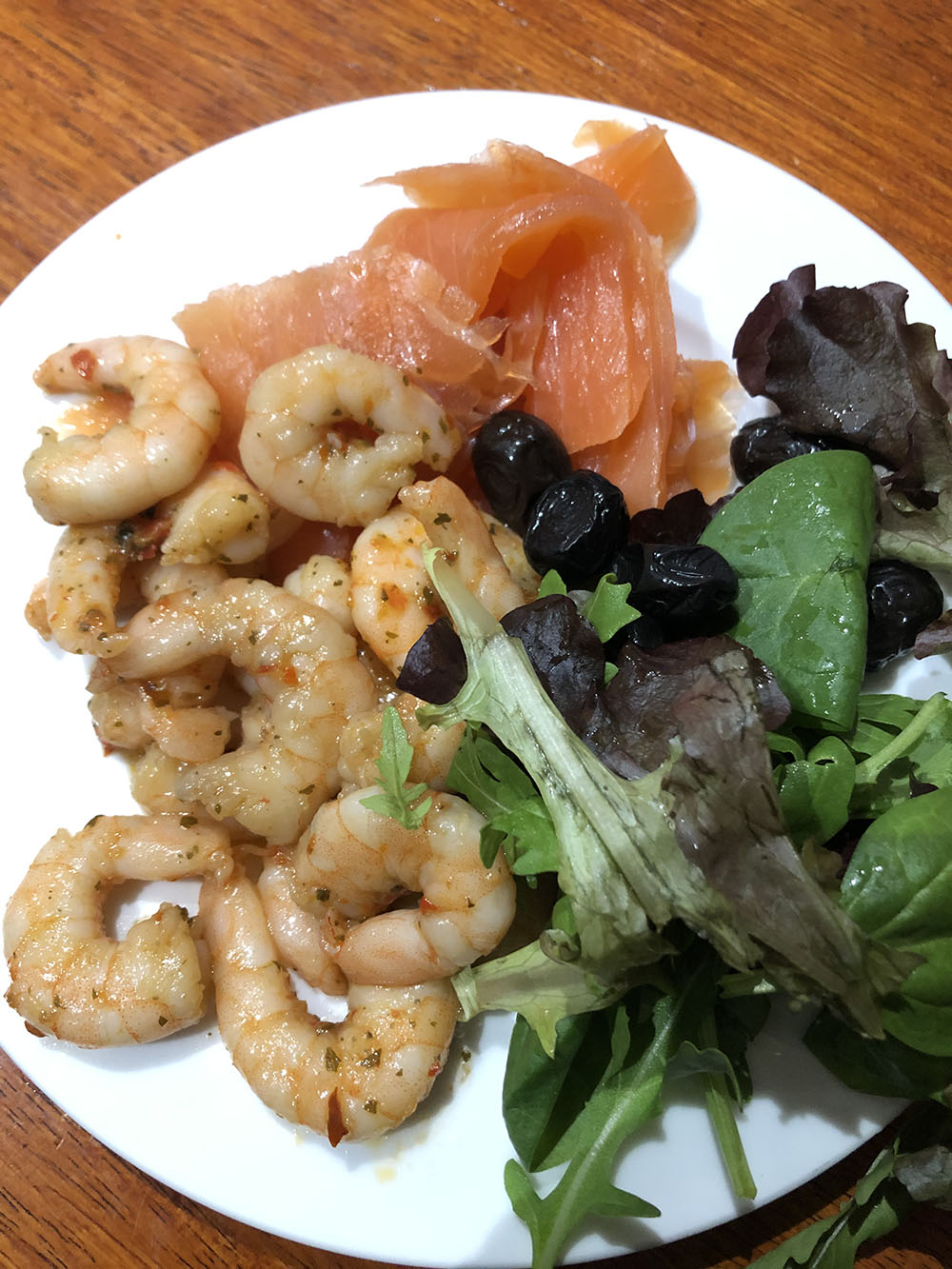
What to do:
- Make sure every meal you have contains some source of protein
- Aim for lean protein sources such as chicken, turkey, fish, tofu and pulses
Choose to snack on fruit, vegetables and nuts
For many people go-to snacks are the naughty ones. You know the ones I am talking about, crisps, biscuits, cookies, chocolate, cheese sticks.
But instead, what you should be eating is fruit, more veggies and nuts.
Fruit is great as a healthy energy boosting snack, but careful not to go too crazy as fruit is still high in sugar. There’s nothing wrong with fruit, but they can affect weight loss results due to the high fructose element that fruit such as banana contains.
So, to be sure fruit isn’t affecting you weight loss goals, stick to one to two pieces of fruit per day to avoid blood sugar spikes.
I know I have mentioned the importance of veggies and fibre and staying fuller for longer, so you won’t be shocked when I suggest that if you are going to snack, it should be on cucumber, celery, tomatoes and carrots.
To be honest, if you are filling up your plates with plenty of veggies and protein for your three main meals then you may not even feel the urge to snack but if you do, make the right choices.
I myself have been snacking on cucumber and cherry tomatoes, but here’s the thing I’m not really allowed too. Because my body type is an endomorph my metabolism benefits most from leaving big gaps in between my meals.
Ideally, and on most days my three main meals fill me up enough so that I don’t need to snack. But some days I’m just so hungry I can’t help it, that’s when I’ll reach for a handful of almonds or a handful of walnuts.
These snacks may not seem like they would do the job of filling you up, but believe me, they actually do.
Food you should have in moderation when trying to lose weight
Carbohydrates are essential in moderation
OK so carbs aren’t the enemy, in fact without them we would be exhausted and miserable 24/7.
Indeed, the beloved carb is the body’s main source of energy and our brains simply wouldn’t function without the glucose that carbohydrates provide.
When we eat carbs, they undergo a process of digestion, absorption, and conversion into glucose. All the carbs we eat are converted into glucose and are sent out into the blood or stored as glycogen – a bunch of glucose molecules linked together and stored for when they are needed for energy, in either the muscles or liver.
Oh and carbs are completely necessary if you are exercising or a busy bee.
If you don’t eat enough carbs, you might be able to get through a couple of good workouts, but sooner or later your ability to recover will be impaired and so will your performance.
High glycogen and blood glucose levels that result from eating carbs will allow you to recover between sets and they can allow you to shorten your rest periods without impacting on your performance.
The key to eating carbs is when to eat them and how much to eat of them. Eating them at the wrong time or eating too much in one go can lead to weight gain – but consuming carbs in general will not result in weight gain.
How many carbs should you be consuming?
- 0-1g carbs per kg bodyweight per day: Sedentary work (office job)
- 1-2g carbs per kg bodyweight per day: Moderately active job (personal trainer, waitress, walking or cycling to work)
- 2-3g carbs per kg bodyweight per day: High activity job (fitness instructor, construction worker)
- 3g plus carbs per kg bodyweight per day: High level endurance or fitness sport training (athlete)
An average woman of 70kg should be eating around 70-120 grams of carbs per day.
Ideally, carbohydrates should be eaten during the day or after a workout, this is because the carbs will be sucked into the muscle to replenish the glycogen stores, rather than just flowing around the blood stream and being stored as fat.
That’s why on days where you would use more energy you can get away with eating more carbohydrates.
On days where you are sedentary however, it’s best to lessen the amount of carbs you eat and avoid eating them too late in the evening when you are using very little energy.
Here is an example of a carbohydrate fueled lunch that included a wholewheat wrap. This was because I needed energy to train later on in the day.
‘Whenever you eat a meal, your blood sugar levels will spike, and your body will use this for energy,’ explains Terry. Which is all well and good if you spend the day in an active state.
‘But if you eat carbs in the evening, the sugar will be in your blood stream, but wont be utilised. This is because in the evenings we are far more sedentary than during the day, we sit in front of the TV and of course we go to sleep.
‘Therefore due to the lack of movement in the evening, the sugar that was meant for energy will be stored as fat,’ adds Terry.
If you still feel like you need your carb fix in the evenings, then choose complex carbs. Nutrient dense complex carbs include sweet potato, butternut squash, quinoa, brown rice, oats and cous-cous.
Complex carbs wont spike your blood glucose like simple carbs (sugar or white bread, pasta and rice) but will still give you energy.
Butternut squash is a perfect example of a complex carb that provides a slow release of carbohydrates that are also full of beta carotene. Butternut squash contains both insoluble and soluble fibre. Soluble fibre has been associated with fat loss as it has been shown to reduce your appetite.
What to do:
- Work out how many carbs you can have a day depending on your body type and activity level – Use this calculator to see exactly how many calories and macros should be eating for your body type.
- Try to avoid eating carbohydrates before bed
- Limit carb intake on less active days
- Opt for complex carbs over simple carbs where possible
Food to avoid for weight loss
High processed food has no benefit other than being tasty so enjoy them as a treat only
Let me make it clear – I am not saying to never eat processed food, that just seems humanly impossible. Some people literally couldn’t live without a McDonalds some crisps here and there and who could blame them?
And there really is nothing wrong with enjoying something like that every so often. But if you are serious about losing weight and making a healthy change, you may want to rethink ‘treating yourself’ too often.
Highly processed foods such as ready made meals, breakfast cereals, refined grains, fast food, crisps, fizzy drinks, bacon and ham are all low in nutrients (or contain none whatsoever) but high in artificial chemicals and preservatives, which are potentially damaging to the body.
Many of these foods also contain hidden fats and sugars that can have a negative effect on your hormones. Plus, high sugar consumption is linked to diseases such as obesity, diabetes, heart disease and even cancer.
Oh and artificial sweeteners in particular can increase your appetite as your body is expecting a large hit of carbohydrate that doesn’t arrive. Sweeteners are also many times sweeter than regular table sugar which can cause even more sweet cravings.
What to do:
- Only consume highly processed food as a treat
- And don’t treat yourself too often.
Come back every week to read Dina’s week by week diary of her weight loss transformation with Terry and Luisa from Your Body Programme, with tips and advice from the experts.
Your Body Programme was founded by Terry Fairclough and Luisa Valenti.
The idea came about after Terry and Luisa saw other personal trainers regularly offering the same generic plan to every client, regardless of gender, goal or body type.
Terry and Luisa are passionate about the need to train everyone as an individual to achieve maximum results, and therefore don’t use a one-size-fits-all approach.
Relevant Healthista Content:
I did a body transformation and lost 11 inches – this is what REALLY works for fat loss
30 day transformation using a low calorie diet
Healthista Content You May Also Like:
7 best Golden Globe body transformations
9 diet rules this celebrity personal trainer lives by
Body transformation week one – operation FAT LOSS
5 fat loss supplements proven by science
Like this article? Sign up to our newsletter to get more articles like this delivered straight to your inbox.



